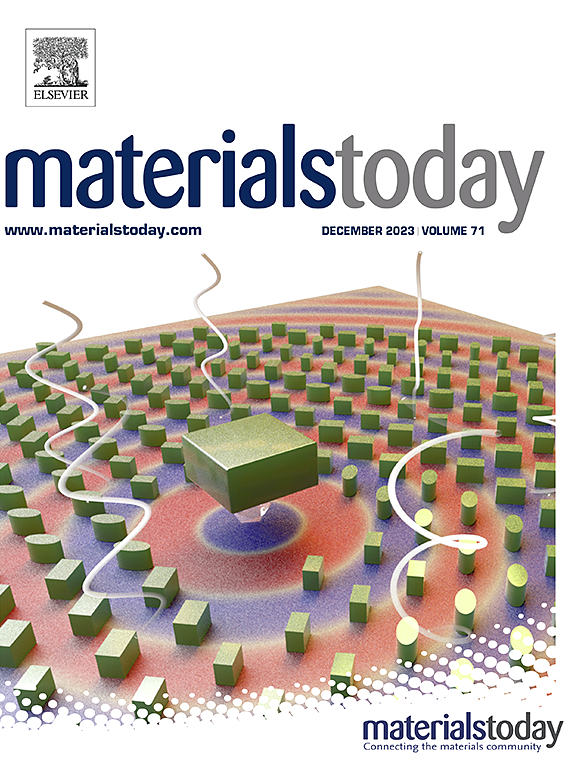Advances in 3D-printed triboelectric nanogenerators and supercapacitors for self-sustainable energy systems
IF 21.1
1区 材料科学
Q1 MATERIALS SCIENCE, MULTIDISCIPLINARY
引用次数: 0
Abstract
In the current era of intelligent systems, the advancement of self-powered energy systems is crucial. With the ubiquitous development of small-scale stable energy systems, a transformative impact on Internet of Things (IoT) ecosystems has been observed. These systems require self-sustaining power-generation and storage capabilities. Triboelectric Nanogenerators (TENGs) have emerged as a prime solution for harvesting mechanical energy at small scales, particularly low-frequency energy, which is often overlooked because of its adaptability to harsh conditions. Supercapacitors (SCs) have attracted attention as promising energy-storage counterparts for TENGs because of their exceptional charge/discharge efficiencies and output characteristics. The integration of 3D printing (3DP) technology with TENGs and SCs, which leverages benefits, such as rapid prototyping, cost efficiency, and compact design, has been proposed as a revolutionary step in enhancing multifaceted artificial intelligence applications. However, the development of 3DP technologies for advanced TENG and SC systems presents challenges, often with a trade-off between optimal performance and practical application. This review methodically categorizes the advancements in surface modification, mechanical systems, and applications of 3DP-based TENGs, along with the material and electrode design and configuration of 3DP-based SCs. Furthermore, it addresses the challenges faced by each category. Thus, this review explored the challenges and prospects of integrating 3DP-based TENGs and SCs as a novel, self-sustainable energy solution to catalyze the next wave of rapid IoT ecosystem development.

用于自我可持续能源系统的3d打印摩擦电纳米发电机和超级电容器的进展
在当今智能系统时代,自供电能源系统的发展至关重要。随着小型稳定能源系统的普遍发展,对物联网(IoT)生态系统的变革性影响已经被观察到。这些系统需要自我维持的发电和存储能力。摩擦电纳米发电机(TENGs)已经成为小尺度收集机械能的主要解决方案,特别是低频能量,由于其对恶劣条件的适应性而经常被忽视。超级电容器(SCs)由于其优异的充放电效率和输出特性,作为极具潜力的储能替代物受到了人们的关注。3D打印(3DP)技术与TENGs和SCs的集成利用了快速成型、成本效率和紧凑设计等优势,被认为是增强多方面人工智能应用的革命性一步。然而,为先进的TENG和SC系统开发3d打印技术面临挑战,通常需要在最佳性能和实际应用之间进行权衡。本文系统地综述了3d打印纳米材料在表面改性、机械系统和应用方面的进展,以及3d打印纳米材料和电极的设计和配置。此外,它还解决了每一类面临的挑战。因此,本文探讨了将基于3d打印的teng和SCs集成为一种新的、自我可持续的能源解决方案,以催化下一波物联网生态系统的快速发展所面临的挑战和前景。
本文章由计算机程序翻译,如有差异,请以英文原文为准。
求助全文
约1分钟内获得全文
求助全文
来源期刊

Materials Today
工程技术-材料科学:综合
CiteScore
36.30
自引率
1.20%
发文量
237
审稿时长
23 days
期刊介绍:
Materials Today is the leading journal in the Materials Today family, focusing on the latest and most impactful work in the materials science community. With a reputation for excellence in news and reviews, the journal has now expanded its coverage to include original research and aims to be at the forefront of the field.
We welcome comprehensive articles, short communications, and review articles from established leaders in the rapidly evolving fields of materials science and related disciplines. We strive to provide authors with rigorous peer review, fast publication, and maximum exposure for their work. While we only accept the most significant manuscripts, our speedy evaluation process ensures that there are no unnecessary publication delays.
 求助内容:
求助内容: 应助结果提醒方式:
应助结果提醒方式:


